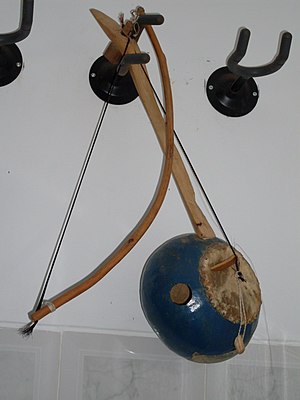Cimboa
 A cimboa with its bow. | |
| String instrument | |
|---|---|
| Classification | String instrument |
| Developed | Cape Verde |
| Related instruments | |
| Kiki, nini, fini (possible) | |
The cimboa (Portuguese pronunciation:
The cimboa is composed
The exact origin of this instrument unknown, but it may be from continental
The usage of this instrument is considered extinct. In spite of having revivals of its construction,[5] nowadays it is used more as a decorative piece,[4] rather than a musical instrument.
References
- ^ Cardoso, Pedro (1933)
- ^ Fernandes, A. N. (1969)
- ^ Nogueira G. (2007)
- ^ a b Gonçalves, C. F. (2006)
- ^ "Cimboa workshop revives endangered musical instrument". A Semana. 2006. Archived from the original on 2007-10-08.
Bibliography
- Folclore Caboverdeano (Cardoso, Pedro; Edições Marianas: Porto, 1933)
- Léxico do Dialecto Crioulo [Modern: Léxico do Dialeto Crioulo] (Fernandes, Armando Napoleão; Gráfica do Mindelo: Mindelo, 1969)
- Relatório Diagnóstico (Direcção Geral de Animação Cultural: Praia, 1988) Survey about musicians and musical instruments existing in Cape Verde
- Os Instrumentos Musicais em Cabo Verde [Musical Instruments of Cape Verde] (Brito, Margarida; Centro Cultural Português: Praia – Mindelo, 1998)
- Kab Verd Band (Gonçalves, Carlos Filipe; Instituto do Arquivo Histórico Nacional: Praia, 2006)
- A música de Cabo Verde pela imprensa ao longo do século XX (Nogueira, Gláucia; own author's edition: Praia, 2007)
External links
- Toca Cimboa, Rapica Tambor Article (in Portuguese) about the Cimboa in Kriolidadi
- The power of Culture — Cimboa Page with a sound clip of the cimboa
- Cimboa workshop revives endangered musical instrument Article published on the on-line newspaper A semana
